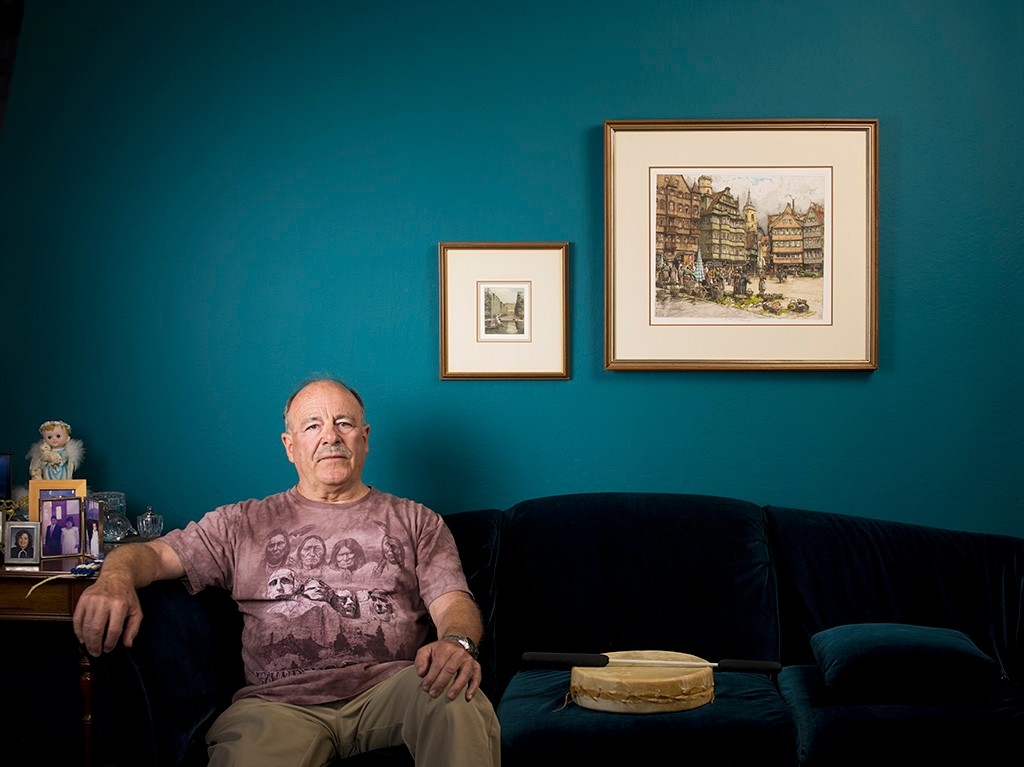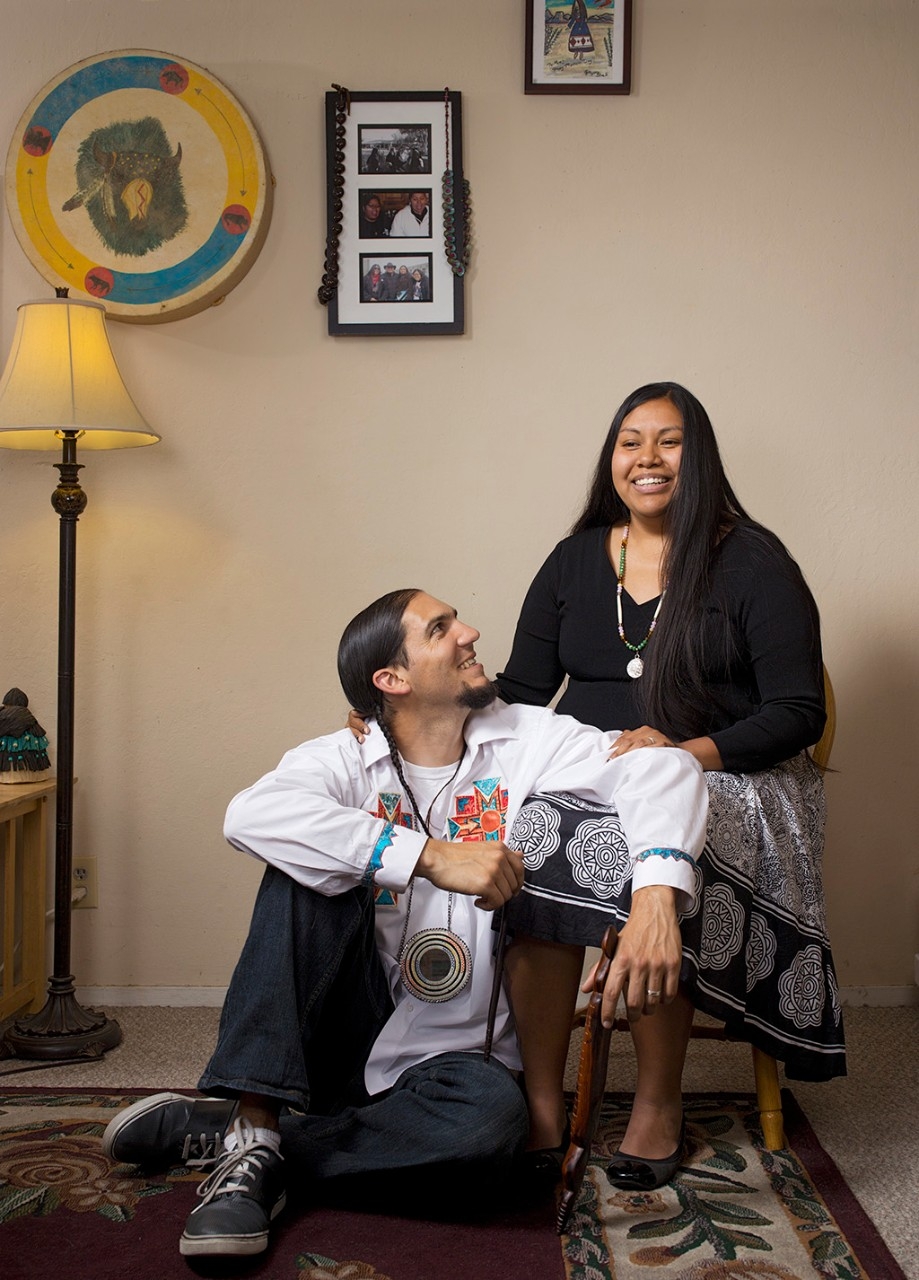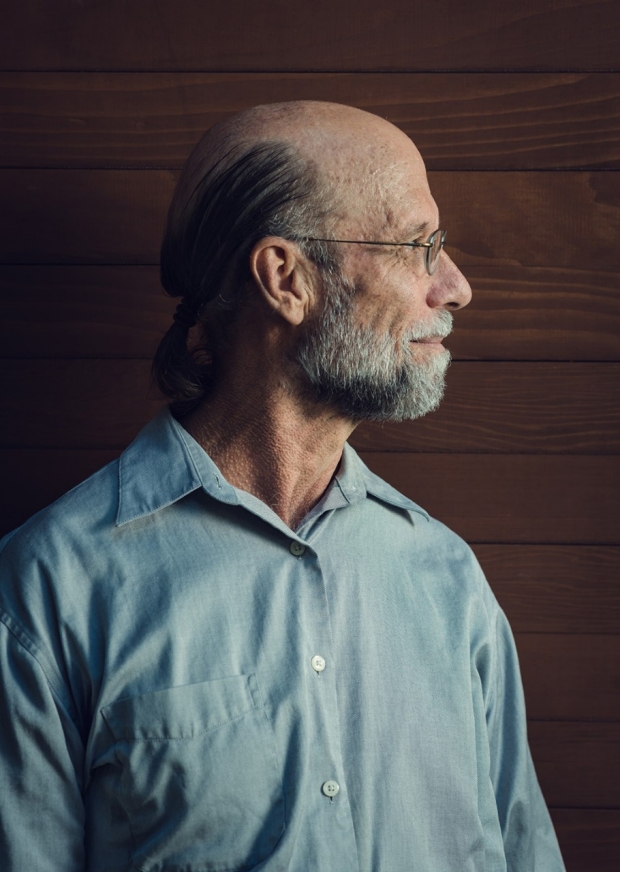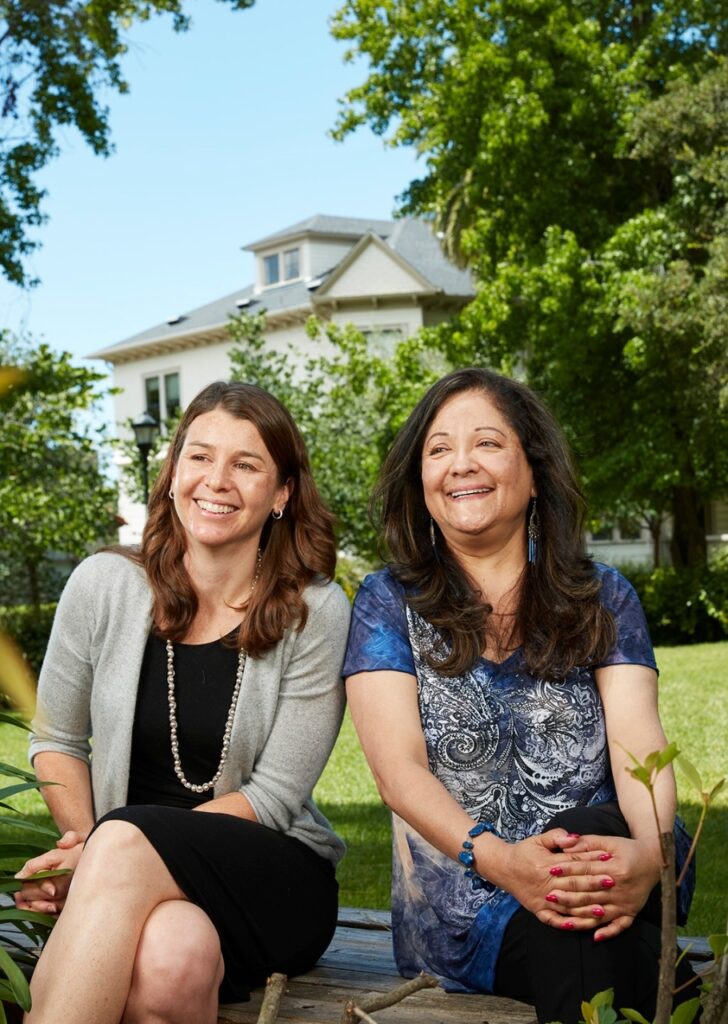In the circle
American Indians and Stanford researchers come together to prevent diabetes

Adrian Kendrick was struggling with irritable bowel syndrome. His mother, a public health nurse, had recommended several remedies, but Kendrick wasn’t getting better. His mother made one last suggestion: a healing ceremony.
Kendrick is an enrolled member of the Oglala Sioux tribe, and grew up on and around the Pine Ridge reservation in South Dakota. But he was also an AT&T executive in the Bay Area, one of thousands of local American Indians straddling two worlds. He was game for his mother to set up a healing ceremony on the Navajo reservation where she was working, but he also kept it “super secret,” he says. “You don’t just do this.”
A Navajo healer performed a nightlong ceremony — “sundown to sunup” — and Kendrick came away “feeling totally revitalized and healed,” he says. “My irritable bowel just suddenly went away.
“So where does it work?” he asks, gesturing to his head, and then his heart. “I don’t know where it works, but it works.”
Kendrick is one of 15 members of the American Indian Community Action Board, which is working with Stanford and San José State University researchers to prevent diabetes in American Indians and Alaska Natives, who are twice as likely to develop the disease as non-Hispanic whites. It’s a rare collaboration. It was initiated by the American Indian community, which can have reason to be wary of medical studies. It is a research partnership with urban American Indians, an invisible majority of the indigenous population, and one with understudied and underfunded health-care needs. And after almost six years of hard work — building trust, seeking funding, surmounting challenges — it is as close to success, in the form of full enrollment in a randomized controlled trial, as any project that aims to examine the root causes of diabetes in American Indians has ever been.
The study tests whether an enhanced diabetes prevention program that incorporates elements of traditional native culture, such as talking circles and storytelling, will be more effective than the standard program offered to American Indians in San Jose for many years. The enhancements aim to address the historical trauma that urban American Indians have experienced as a result of loss — of land, of family, of culture — trauma that, researchers say, can accumulate over generations and may be at the root of unhealthy lifestyle behaviors.
“American Indians have one of the highest diabetes rates in the entire world,” says Lisa Goldman Rosas, PhD, consulting assistant professor at the Stanford Prevention Research Center and assistant scientist at the Palo Alto Medical Foundation Research Institute. “The stakes are high, and I think the group really sees that. Every time we encounter a challenge, we all feel a responsibility — we’re the only ones who have gotten funded to do this.”
‘They knew nothing about the American Indian population, and we knew nothing about research.’
Sixteen people a year. In the mid-2000s, health educators Jan Vasquez and Ramin Naderi, who worked at a community health center in San Jose, had funding from the Indian Health Service to offer its group-based diabetes program to 16 people a year. The IHS had adapted the program from the landmark Diabetes Prevention Program trial, which had shown that losing 7 percent of body weight and increasing physical activity to 150 minutes per week was effective in warding off Type 2 diabetes among high-risk adults. It had a 22.5 percent success rate nationwide, but Vasquez, who has Apache and Comanche heritage, wasn’t satisfied. She was worried that the gains might be temporary, and thought perhaps the program could be strengthened.
So Vasquez and Naderi started presenting data about their participants at conferences nationwide, in the hope they would find an academic partner to conduct further research. At a conference in 2010, they bumped into Rhonda McClinton-Brown, a former colleague who now runs the Office of Community Engagement within the Center for Population Health Sciences at Stanford Medicine. Part of that office’s charge is to pair faculty with community groups so they can jointly conduct research.
McClinton-Brown’s matchmaker’s instinct pointed her to Randall Stafford, MD, PhD, professor of medicine at the Stanford Prevention Research Center, and Goldman Rosas, who were already comparing different approaches to diabetes prevention among Latino immigrants.
“It was a very nice pairing up of Lisa and me with the community,” says Stafford. But by no means did the researchers take it for granted that they would be able to establish a strong research partnership with local American Indians.
“It strikes me as a population you better know a lot about because there have been so many injustices,” Goldman Rosas says. A particularly cautionary tale: In 2003, the Havasupai Indians banished Arizona State University researchers from their reservation. At the tribe’s request, the researchers had conducted a genetic study on diabetes, which has sky-high rates among the Havasupai. And, under a broadly worded consent form, they had also used the Havasupai’s DNA samples to study such taboo topics as schizophrenia, inbreeding and migration — to the tribe’s surprise and distress. There was a lawsuit, and a six-figure settlement, and a pledge by the university to “remedy the wrong that was done.”
That was the story the new partners did not want to tell.
“I’ve always been reluctant to pair up with universities or colleges,” says Al Cross, a retired social worker of Hidatsa and Mandan descent who was the first person to join the project’s community action board, or CAB. “Somehow it seems that we get appropriated.” This study, though, addressed something he thought was important: historical trauma. “That was the big entrée for me to get involved,” he says.
It took a few years to establish trust between the CAB and the researchers. “We entered into this long period of getting to know each other,” says Stafford. “Part of that for Lisa and me in particular was getting to know more about the community, learning more about the situation of urban American Indians, and educating ourselves about the important historical features of why people came to urban areas on the West Coast — it wasn’t all so benign as people just moving to the cities.”
Both partners had expertise to contribute and new knowledge to gain, which helped create a sense of equity, Vasquez says. “They knew nothing about the American Indian population, and we knew nothing about research.”

In 1940, only 8 percent of American Indians lived in cities. By the end of the decade, federal agencies had begun to provide job assistance to those who were willing to relocate from reservations to certain designated cities in the West and Midwest. It was the latest chapter in the long and contradictory history of federal Indian policy, which has seesawed between segregating American Indians onto reservations and encouraging them to assimilate.
It had devastating effects. Those who relocated saw their family and community ties fray. Those who stayed saw their chances of maintaining robust tribal nations dwindle.
“When the Indians came to the city, the government was hoping they would lose their Indianness,” says Cross, who relocated to San Jose in 1960, at the age of 25. “It was just the opposite. Indians became really acutely aware of their own identity.” It was a new kind of identity, though — one forged by small numbers of people from different tribes, coping with isolation. “There were not enough to make an enclave,” Cross says. “There were not enough to command any kind of attention in the city. So the name ‘Indian’ became more general. Culture and identity were the main victims.”
Today, at least 70 percent of American Indians in the United States live in urban areas. San Jose, one of the major relocation destinations, is home to about 50,000, representing more than 100 different tribes. Many are now second- and third-generation urban residents who have limited or no connection to tribal lands.
“What Indians who grew up in the city don’t understand is the importance of that land,” says Cross, who grew up on the Fort Berthold reservation in North Dakota. “There’s an identity attached to it.”
As the research team learned more about the cumulative impact of historical trauma across generations, they began to hypothesize that a diabetes prevention program that addressed its effects might be more effective than one that didn’t.
“People’s current-day behaviors and their problems aren’t just something they can overcome with willpower,” Stafford says. “People are living with the problems that their grandparents, great-grandparents and so forth have been subjected to.”
“We all have family, friends and children we are worried about, especially in terms of diabetes,” says Vasquez, who was motivated by the project to obtain a master’s degree in public health with an American Indian specialization, and now serves as the project’s research director. “Historical trauma is affecting everything you do. The social support system is broken down. Your family has changed. Your whole life is filtered through these things: lack of identity, never fitting in, never feeling like you belong anywhere — because you really don’t.”
Given this fragmented sense of identity, the researchers and the CAB knew they had to proceed thoughtfully in developing the study’s cultural enhancements. They decided to use an inclusive, pan-tribal approach. “There are those who say you should only learn your ways, and then there are those who are saying, learn something, otherwise you’re just fulfilling what the United States government wanted to do in the beginning anyway, which was to eradicate the native people here,” says CAB member Paul Flores, alluding to a history of armed conflict, often over land, that dates to the colonial era. “When we don’t practice our culture, we ourselves are completing that job that the government started.”
In this type of equitable research collaboration, there’s a continuum of typical community involvement, says Goldman Rosas, ranging from conducting outreach and raising awareness about a study to actually participating in the study. “This falls off that spectrum,” she says. Because the study was initiated by the community — which is rare — it has a special dynamic, Goldman Rosas says. “It is community-driven and community-run.”
The researchers and the CAB worked in tandem to develop and pilot-test enhancements to the diabetes prevention program. It wasn’t that the standard IHS program, in which a lifestyle coach used behavioral strategies in 16 weekly group sessions to promote moderate calorie restriction and physical activity, was ineffective. For instance, Kendrick, the former AT&T executive, had completed it successfully in 2013, losing 20 pounds and reversing prediabetes. But with attention to historical trauma, maybe it could be improved.
‘Our people don’t just define physicality as health. Medicine is not something out of the cabinet.’
The standard program — which serves as the control for the randomized controlled trial now underway — is lightly tailored to American Indians, “just in terms of the branding of it, suggestions about physical activity emphasizing, let’s say, dance, over playing tennis,” Stafford says. “We began to think about, well, what are the types of enhancements that people would value and might make the experience deeper and more transformational for people?”
The researchers and the CAB came up with three: talking circles, a traditional method of group communication and problem solving; digital storytelling, a modern adaptation of oral tradition in which participants reflect on their lives and their health; and a photography project in which participants take pictures in response to questions about health, relationships, challenges and purpose. Participants are also given opportunities to participate in cultural celebrations that emphasize health and well-being. The intervention staff guides participants to the enhancements that seem most likely to help them grapple with their challenges, reinforce their cultural identity and enhance their social support.
“The idea is to identify health as something that is valued by the American Indian community, not just Western medicine,” Stafford says. Participants might begin to see that “exercise isn’t something that’s a prescription that the doctor is giving, but is doing something with movement that our ancestors did,” he says. “Or dietary changes really aren’t so much about extracting this or restricting that, but also looking back at how did our ancestors approach diet?”
“Our people don’t just define physicality as health,” says Paul Flores, a computer technology instructor at a local elementary school. “Medicine is not something out of the cabinet. Medicine could be a song; it could be a prayer; it could be food. So we had to keep that in context.”
McClinton-Brown says this project embodies the “pure sense” of a community-researcher partnership, the kind her office teaches about but doesn’t always get to see put into practice. The CAB, she says, is fully engaged in all aspects of the research. Several members contributed to the writing of the academic papers, and there are plans to write about the study for community publications in Indian Country. “I’ve never actually seen that before,” she says.
“I get the sense people come to the meeting because of something much bigger than the diabetes study,” Goldman Rosas says. This is especially true when a project hits the kind of roadblocks this one has. “The challenges are more severe than on any project I’d ever been on,” she says.

For starters, the researchers were unable to obtain funding from the National Institutes of Health because of the lack of data connecting historical trauma to unhealthy lifestyle behaviors. Moreover, they were troubled by comments on their grant application to NIH’s National Institute on Minority Health and Health Disparities: In questioning assimilation of urban American Indians, one reviewer used the derogatory term “half-breeds.” (The study eventually secured a grant from the Patient-Centered Outcomes Research Institute.)
Then Vasquez — the fulcrum of the project — was let go from the community health center at which she worked, without explanation. Goldman Rosas says she has since learned this is “really common” in organizations that serve American Indians. “When I freaked out about it and called the scientific advisers and the CAB, everyone was just like, stay the course; this is par for the course,” she says. Vasquez alighted at the San José State University Research Foundation, and the researchers were able to modify the PCORI grant accordingly. “I couldn’t do this project without Jan,” Goldman Rosas says.
Small issues keep popping up: What is an appropriate data-retention period that allows the researchers to complete their work but doesn’t create mistrust in the community? Where should the question about race and ethnicity appear on the questionnaire? (Not at the beginning, said the CAB. It’s too traumatizing.) “I’m used to that question for Latinos being complicated, but not traumatizing,” Goldman Rosas says.
“A lot of the things that go on in working in American Indian communities are really out of this trauma we’re talking about,” Vasquez says. “That’s why I think we’re so unique and amazing. When we talk to people all around the country, they ask, how did you get this far? How are you still together? How are you accomplishing so much?”
In fact, “there have never been challenges with the CAB,” Goldman Rosas says. When the board was without a place to meet during Vasquez’s job transition, they convened at a restaurant. “They were kind of unfazed by the whole thing, which gave me hope,” Goldman Rosas says. She characterizes their reaction as, “A terrible thing has happened, well, see you next week.”
“Which really says a lot about the community and what they go through,” Vasquez says. “It’s like, ‘You haven’t seen trauma.’”
It’s one thing when Kendrick tells you that many of his classmates back on his South Dakota reservation have died of complications from diabetes. He’s 71. It’s another when Orena Flores, who spent her childhood on the Fort Yuma reservation in Winterhaven, California, says the same. She’s 32. “They’ve already passed on. A lot of them have,” she says. “There’s so many who are unhealthy, overweight and just sick. I want that to stop.”
Orena Flores teaches the enhanced classes for the study participants, the classes infused with elements of native culture. In addition to providing a standard diabetes prevention curriculum, she leads talking circles for the groups of five to 10 participants. The talking circles are informed by her Fort Yuma Quechan, Maricopa and Mojave heritage, and she explains how they may differ from those of other tribes. That resonates with some; for others, it’s their first time in a talking circle.

“A lot of them say, ‘I want to come and learn my culture.’ And that’s where I start,” says Orena Flores, who is active in a traveling native dance troupe and is married to Paul Flores. “I think I’ve helped the people who identify as Native American but they’re not really sure what tribe. I say, ‘That’s OK. A lot of people are like that. It’s from history and things that happened. It’s not your fault. So let’s find something that fits you.’ ”
Initially, she says, many participants are focused on losing weight, stat. “We’re not focusing on just weight,” Orena Flores tells them. “We’re focusing on making a gradual change in life.”
When making that gradual change gets discouraging, peer mentors like Kendrick are there to support participants. “I know where you’re going to be when you hit, let’s say, week eight or nine, when you start talking about eliminating or defusing negative thoughts,” he says. “Will people backslide? Absolutely. Will people lose their way? Sure. But they’ll fall back on how they connected to their heritage and find some inner strength.”
Once a week, at the end of class, Paul Flores comes in to help participants create multimedia digital stories. “I tell them our history has a rich culture of storytelling. And we want to keep our traditions alive, but we’ve put a modern twist on it, which is why we call it digital storytelling. When you tell a story, you gain power over that story. So if your story is going to be one of redemption, or overcoming an obstacle, the more you tell a story, the more power you’re going to have over that incident in your life.”
By the end of the 16 weeks, the tenor of the group has shifted. “Once they get motivated, they start motivating each other,” Orena Flores says. “When the classes are ending, they’re all a group together that has formed a bond, and I love seeing that. As long as that seed is planted and they’re able to go out and spread it, it’s wonderful.”
“This whole idea of transformation is about getting each individual to step up, to be motivated around their own health and the health of the community, maybe in a way that’s greater than what we would expect within the control group,” Stafford says.
Although it’s a little hard to speculate about future research before results are in hand, Stafford sees some “logical next steps” for the partnership. One might be to develop a program for managing diabetes. “There is truly a value in working upstream and trying to prevent the disease,” he says, “but you’re not going to always be successful, and there’s a population out there that needs help.”
Inspired by conversations with Al Cross, McClinton-Brown envisions research on the health and economic impacts of relocation over generations. “The CAB has the capacity to seek and get additional funding,” she says. “Lisa is in it for the long haul. Randy is very invested. The trust is there.”
Several CAB members, including Orena and Paul Flores, have a broader vision in mind. “If the community participates in this, and we do well, then not only will we have healthier native people, but we will be on the next step to building the ultimate goal,” Paul Flores explains. “We want to establish a community center.” There, he’d like to equip American Indian kids — “because I love the kids; that’s our future” — with computer skills such as graphic design, web design and animation. Orena Flores pictures a vibrant gathering place that offers native dance classes and powwows with healthy foods. “It can’t just be diabetes prevention; we’ve got to offer more,” she says. “We are a very good, powerful group, and we will get it done.”

